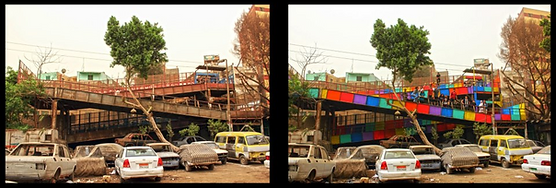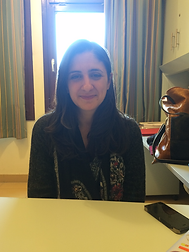
Wandering Minds
Different Forms of Underground Art
Evolution of Graffiti
By: Hana Mandour
One day in Oct. 2010, Amr Nazeer received a phone call from his cousin asking him to participate in a collective act of nobility. Amr agreed to the request without one grain of hesitation. Until this day, Amr is proud of what he did.
Sitting with his back straight, staring at his hands in front of him, Amr recalled his first experience with graffiti with eyes that were absorbed in the past. He went on to talk about his experiences with the newly adopted art throughout the Jan. 25 uprising which ousted former President Hosni Mubarak, and the days that followed.
Graffiti is a form of art that includes scribbling or spraying words and drawings on the walls of public places. This form of art has existed ever since cave men were alive as it was used as a way of communication. However, it only began to flourish in Egypt with the start of the infamous 18-day protests where millions of protestors had gathered in downtown Cairo to push for political reforms.
“The revolution was what triggered people to draw graffiti,” said Amr, adding that his first graffiti campaign advocated for change. Amr recalls his first graffiti that consisted of a gripping hand with a statement underneath saying “yes for change.”
Several reasons pushed people like Amr to advocate for change. Some of these reasons included Mubarak’s dictatorship style of ruling for three decades, the absence of basic human rights and freedoms, police brutality against activists and opponents of the ruling regime, high unemployment rates, sky-rocketing inflation and low income
 .
.
Pre-revolution graffiti
Before the 2011 revolution, graffiti was only seen on the streets as a form of guerilla marketing – a marketing strategy that uses shocking low-cost teasers to create buzz. – Every now and then, graffiti showing images of random faces surfaced on public walls. Graffiti artist Aya Tarek, was among the first artists who participated in this illegal act. Aya claims that the drawings were not politically motivated but rather advocated for women's rights. Amr believes that any form of self-expression is in some way political. On the other hand, Bahia Shehab, associate professor of professional practice at the American University in Cairo, sees that while some of the pre-revolution graffiti was political, others were just interesting attempts of artists experimenting in the city.
Revolutionary graffiti
During the 18-day sit in protests, graffiti gradually appeared on downtown walls in its primitive form. Artists sprayed words instead of symbols and drawings. “It was beautiful to walk around and see curses directed at the old regime written on the walls,” said Amr, explaining that the anger displayed on the walls was the result of years of frustration directed toward the Mubarak government.
The graffiti in the first 18 days was not as emotional, said professor Shehab adding that the interesting discourse and conversations artists had started after the 18 days and the disappointments following it. “Graffiti was like cartooning, you comment on the events,” she said, explaining that the drawings were a result of the events taking place.
One of the famous graffiti images was a painting of the martyrs done by artist Abou Bakr Ammar during the presidential elections which followed. Ammar went on the streets and sprayed his infamous painting which said: “forget who died and focus on the elections.” Afterwards, he painted the mothers of the martyrs on top of his work. Shehab said she was personally touched by Ammar's artwork. “I felt that this is someone who really understands what I want to say and he said it much more beautifully than I could have ever said it,” said Shehab.
Another famous graffiti campaign was titled “No and a thousand times no,” done by Shehab herself. “All of the no’s were comments on certain events, they were not no’s coming from the void,” Shehab explained. Examples of this campaign were “no to snipers” following an event that involved snipers shooting at protestors and “no to stripping the people” following an event where security forced dragged a woman; stripping off her clothes.
Post-revolution graffiti
Graffiti artists became more inclined to react to the events that followed the revolution through bold images and symbols. “The ideas that came to us in the spur of the moment were usually the best,” Amr admitted. He said that the best graffiti he has done involved drawing a smiley face on the walls of Asr El Eini street in downtown Cairo following clashes between security forces and and protestors which killed 23 people and injured 1500 in Nov. 2011.
Shehab agreed with Amr, saying that the graffiti of what followed the 18 days of January’s revolution was extremely emotional, very creative, intense and wild. “I didn’t know them in person but you could tell. Their personality showed, their background and their culture, it all showed,” she added.
Amr thinks that the notion of using public space to communicate is coming to light in Egypt. He says that more artists now are able to get permissions to draw on public walls. Shehab, on the other hand, sees that graffiti has remarkably shrunk since current President Abdel-Fattah El Sisi was elected. The ex-Military General is accused by some activists of imposing restrictions on freedom of expression, imposing journalists and implementing tougher sanctions on protestors. “A 17 year-old graffiti artist was found drowned in the Nile. So the message was very clear; you are not welcome on the street,” she said, adding that the penalty for drawing graffiti is four years in prison and a 15-20 thousand Egyptian pounds fine.
Amr sees that graffiti is a form of art that has grown and evolved during the revolution and that is still evolving. One day, new generations will come who have not witnessed the revolution, and then, they will draw graffiti that doesn’t have to do with politics, Amr commented, “we will proceed from there.”
Youtube: Bahia Shehab: A thousand times no
Bahia Shehab is Associate Professor of Professional Practice and a graffiti artist. She shares her story in TEDx. She talks about the origin of her campaign "No and a thousand times no" as well as she explains what each "no" means.

This graffiti was drawn by Amr Nazeer on the walls of Maadi club. It shows how Tunisia is overcoming its obstacles in the race for freedom.

Nazeer initiated the campaign "Coloring Through Corruption." The purpose of this campaign was to use beautiful colors to expose corruption and make it stand out. This is one of the works that he and a group of his friends had done in Maadi.

This is the smiley face done by Amr Nazeer that was drawn on the walls of Asr El Eini street.

Amr Nazeer - Graffiti Artist
Amr Nazeer is a graffiti artist who has started drawing graffiti right before 2011 revolution. He talks about what pushed him to draw and how he views graffiti.

Bahia Shehab -Associate Professor of Professional Practice
Bahia Shehab, Associate Professor of Professional Practice talks about how graffiti has evolved from before 2011 revolution up until now. She also talks about her graffiti campaign "No and A Thousand Times No."